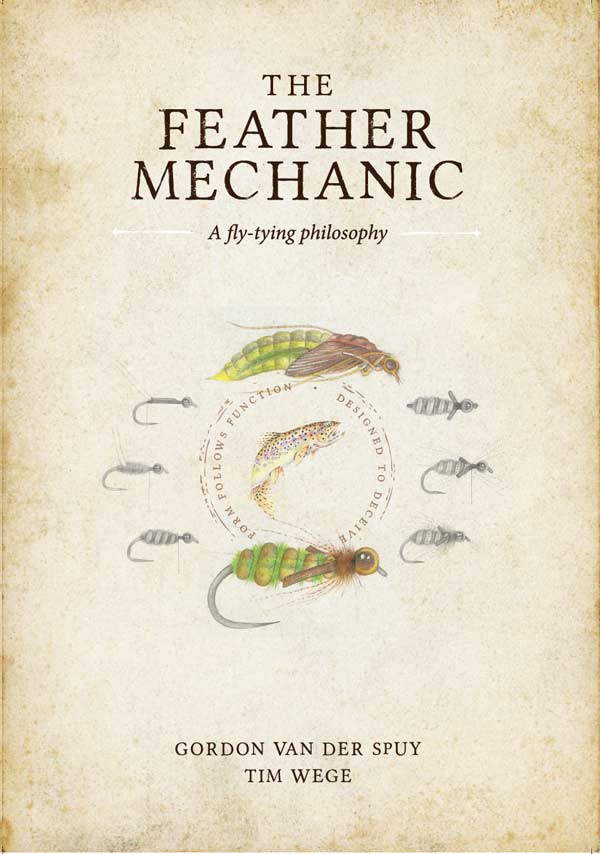Written by: Gordon van der Spuy
Excerpted from the new book The Feather Mechanic: A Fly Tying Philosophy, by Gordon van der Spuy.
A lot of people approach tying from an aesthetic point of view, paying more attention to what the fly looks like as opposed to how it will behave or fish. We’re pattern-orientated, as opposed to being purpose-orientated, and in many ways, I think we’ve got this whole thing the wrong way round. I don’t think you can tie effective flies consistently without thinking about how you’re going to fish them.
I remember fishing a favourite spot on the Vaal River as a young boy. The guy standing in the run next to me was absolutely hammering fish. He had one on just about every cast, while I stood there fishless. Eventually, I couldn’t take it anymore and walked up to him to ask him what he was doing. “You need to get the flies down,” he told me. “The water here is fast and the drifts are short. If the fly doesn’t get down immediately chances are the fish won’t even know it’s there. Give me your fly,” he said. He took a large split shot from his top pocket and crimped it onto my tippet with his teeth a few centimetres above my fly.
“Try it now,” he said with confidence. I lobbed the fly out in front of me and got savagely taken on the first drift. It was as easy as that. One small change and BOOM!
A fly can be tied perfectly, but if it doesn’t efficiently get to your intended quarry, it’s pointless. You can’t tie an effective fishing fly without thinking about how, when, and why you are going to fish it. You need to sort this out before tying the fly.
If you need a fly to sink, you must design it to do that.

What makes a fly sink? Weight? A lack of resistance on the sink? Or a combination of the two? If you want a fly to get down quickly, you need to keep it as sparse and aquadynamic as possible. You want a fly that has weight but that is devoid of unnecessary bulk which would otherwise add resistance on the fly’s descent and slow its sink rate. The tippet used also makes a massive difference. Tippets with finer diameters sink quicker due to less resistance on the sink.
If you need a fly to sink slowly, you must design it to do that.

What hampers a fly from plummeting at pace? Resistance. You might still want a bead on the fly to get it to break through the surface film, but you’ll probably use a glass bead which will be much lighter than a tungsten bead of the same size. Flies which sink slowly will be used in still waters and areas of the river with marginal flow. Fish will have more time to inspect a fly, so inbuilt movement in the fly will become important. Materials like Cul de Canard (CDC) and squirrel dubbing will help with resistance and add movement at the same time.
If you need a fly to float in fast currents, you must design it to do that.

Here, structure is what you’ll be after. Materials like genetic hackle and deer hair, which are stiffer and which hold their shape in the faster currents, will be useful. Parachute patterns work well because their design allows a larger surface area of the water to be occupied by the material on the fly, aiding both the stability and floatation of the pattern.
If you need the fly to present with a loud plop, you must design it to do that.

Here, density will be important. Materials like foam will give you the plop you need.
How a Pattern Becomes “Tried And Tested”
Time spent on the water casting flies at fish and seeing how they react to them is as much a part of fly design as sitting at the vice. Imitation is great, but don’t let it limit you. Sometimes veering off the path of convention can be a good thing. There isn’t a single nymph that I know of that has pink in it, yet flies with pink beads can be deadly for both trout and grayling. Someone had to try that out to figure out that it was effective. As a child, I’d often fish a lightly weighted flashback pheasant tail nymph to rising fish in still-waters. The pattern would typically be retrieved through the feeding fish with a fast figure-of-eight retrieve interrupted by the odd pause. I’d often take fish after the pause. Fastmoving mayfly nymphs might not be natural but in the same breath.

I’ve never seen a ball of wool move on its own and neither has your pet cat, but move that ball of wool and see what happens. Cats love chasing unnatural moving balls of wool. Trout very often react in the same way to a small nymph moved quickly and sporadically. It’s not natural, but it works!
Don’t be scared to experiment and try different things even though they might seem crazy at the time. Competitive anglers are particularly good at this. One could say they’ve become accustomed to pushing piscatorial boundaries. The “Squirmy Wormy” and the “Mop fly” are prime examples.
Gordon van der Spuy is one of South Africa’s foremost fly tiers and fly-fishing instructors. To order a copy of The Feather Mechanic: A Fly Tying Philosophy, send an email to Evan D Brant at sidelinghillhackle@gmail.com.

Credit: Source link































